ds
LEGO Rock Band DS
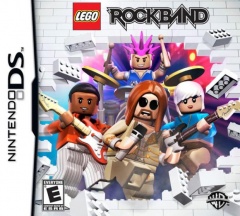 Rock Band 3 is due out very soon and I just read that there will be a Nintendo DS port of the game. Unlike Guitar Hero: On Tour, there will be no bonus peripherals used to control the game, just the regular buttons. If this sounds odd to you, well, the experience is already available! Harkening all the way back to Harmonix's first game, Frequency, released in 2001.
Rock Band 3 is due out very soon and I just read that there will be a Nintendo DS port of the game. Unlike Guitar Hero: On Tour, there will be no bonus peripherals used to control the game, just the regular buttons. If this sounds odd to you, well, the experience is already available! Harkening all the way back to Harmonix's first game, Frequency, released in 2001.
After Frequency and Ampltude grew a cult following, the rhythm music game world exploded with Guitar Hero and Rock Band. No more would we press mere buttons on a controller, but now we will press buttons on a plastic guitar (not hating, I love the Rock Band series)! I thought we would never see the classic button pressing gameplay ever again, but gaming history likes to repeat itself, and I recently discovered that Harmonix has brought it back with Rock Band: Unplugged and LEGO Rock Band DS.
Seeing as I don't own a PSP, I sat down to the odd combination of LEGO and Rock Band. Released about a year ago alongside its PS3/Wii/Xbox 360 big brothers, the DS version was hampered with a smaller soundtrack and no downloadable content, but it is available on the go. And of course, if you're a fan of Frequency and Amplitude, then it might be time to return home.
Professor Layton and the Unwound Future
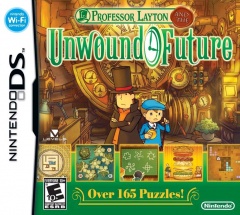 Here
we are back for the third year in a row with another Professor Layton
game. The series has definitely become an annual event that I look
forward to as the games are enjoyable to play and chock full of
challenging puzzles. I’ve compared the Professor Layton series to the
Phoenix Wright series before, as both sets of games offer unusual types
of gameplay on an annual basis. But some other similarities are starting
to creep in, and that’s the feeling of staleness.
Here
we are back for the third year in a row with another Professor Layton
game. The series has definitely become an annual event that I look
forward to as the games are enjoyable to play and chock full of
challenging puzzles. I’ve compared the Professor Layton series to the
Phoenix Wright series before, as both sets of games offer unusual types
of gameplay on an annual basis. But some other similarities are starting
to creep in, and that’s the feeling of staleness.
The series hasn’t evolved a lot in three games, this isn’t necessarily a bad thing as the puzzles are great and the stories always intriguing, but it’s starting to feel like I’m playing expansion packs instead of brand new games. I awarded the first game, Curious Village, a 9/10 and its sequel, Diabolical Box, an 8/10, and I’m about to hand out a 7/10 to Unwound Future. I put a lot of value in mixing things up and trying something new, and the Professor Layton series just isn’t going anywhere. This isn’t to say I didn’t enjoy my 20 hours with Unwound Future, but I’d really love for something more.
If this is your first Professor Layton game, you can expect a point and click style story-driven game with tons of unrelated puzzles to keep you interested. There isn’t any prior knowledge required to play Unwound Future, so it’s definitely a series someone can jump into at any point. Here’s my full review of Professor Layton and the Unwound Future. If you’re curious, I also have a half-hour handheld review up too.
Professor Layton and the Unwound Future
 Professor Layton and the Unwound Future is the third game in the popular point and click puzzle series on the Nintendo DS. Since I love the series and was going to play the game no matter what, I've decided just to play the first half hour for my readers so you can get a taste of what's to come. Having just been released last week, Unwound Future appears to be another great entry into the series.
Professor Layton and the Unwound Future is the third game in the popular point and click puzzle series on the Nintendo DS. Since I love the series and was going to play the game no matter what, I've decided just to play the first half hour for my readers so you can get a taste of what's to come. Having just been released last week, Unwound Future appears to be another great entry into the series.
For those unfamiliar, the Professor Layton series is developed by Level-5 (yeah, the developers of Dragon Quest IX, these guys are on a serious portable roll) and the first two games in the series were also released on the Nintendo DS. Curious Village saw the North American light in early 2008 and Diabolical Box about this time last year. The games, like the Ace Attorney series before it, are always seeming to play catch up with the Japanese releases; Unwound Future was released two years ago in Japan and the unannounced-outside-Japan Spectre's Flute was released last year. The one nice thing about playing catch up is that you know the great games will continue rolling our way for at least a few more years.
Professory Layton is a fun mix of the point and click genre and Mensa-like brain teasers. The story progresses as you discover clues and solve puzzles, and will seriously push your brain to its limit as the game progresses. As someone who enjoys this kind of challenge, this series has quickly become one of my favorites.
So can Unwound Future continue the series' success with me? Let's play and find out, here's its first half hour.
DK: Jungle Climber
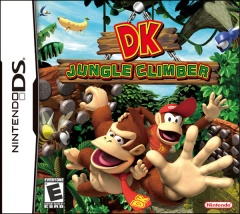 One of the more common complaints you'll hear from Nintendo ex-fans is
that the Big N hasn't made any new franchises in a very long time. For
evidence, critics often point to Super Smash Bros. Brawl,
the game that has become a showcase for iconic Nintendo characters past
and present, and correctly note that none of the game's playable
characters are from a franchise created after 2001's Pikmin.
You'd think the one game that celebrates the whole history of
Nintendo's creations would put some recent stars at the forefront, and
yet there are none.
One of the more common complaints you'll hear from Nintendo ex-fans is
that the Big N hasn't made any new franchises in a very long time. For
evidence, critics often point to Super Smash Bros. Brawl,
the game that has become a showcase for iconic Nintendo characters past
and present, and correctly note that none of the game's playable
characters are from a franchise created after 2001's Pikmin.
You'd think the one game that celebrates the whole history of
Nintendo's creations would put some recent stars at the forefront, and
yet there are none.
There's a point to be made there, but I don't
think it's that Nintendo isn't creating new experiences. Nintendo has
been delivering unique titles all along, but skinning them with familiar
faces in an effort to grab the mass-market that buys based on brand
name alone. It's a practice that probably went into full swing after the
amazing success of Super Mario Kart,
a racing game that could have been released with the image of any other
combat-focused racer and nobody would have ever thought to liken it to
the Super Mario series. Nintendo found a way to make the racing formula
mesh with a beloved franchise and exploited the mustached plumber's
image for instant brand recognition on a whole new product. It wasn't
long before every Nintendo character became a pitchman: the
ever-adaptable Kirby was a given, and other Mario-verse mascots like Yoshi and Wario weren't stretches either, but even seemingly untouchable characters like Samus and Link are now lending their images to genres that only vaguely fit into their traditional roles.
Enter DK: King of Swing on the Game Boy Advance in 2005. The game could be categorized as a platformer, but the focus on running and jumping had shifted to climbing and swinging, using the system's shoulder buttons. King of Swing received enough positive reviews and
sales to spawn a sequel, DK: Jungle Climber, for the Nintendo DS in
2007. Like many hardcore gamers, this game launched well under my radar,
but I recently gave the game a shot. Is the stigma of a spinoff
warranted, or will I see something new underneath the same old monkey
business?
Broken Sword: Shadow of the Templars
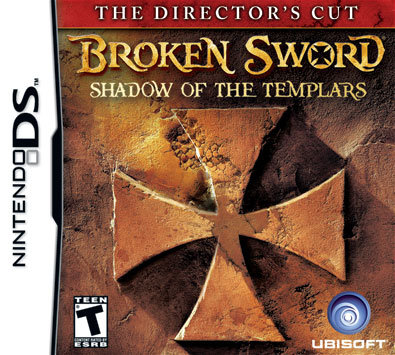 Broken Sword is not a new game. In fact, it was released back in 1996, a year so far gone that I barely remember anything about it. I know I did not experience Broken Sword then or even heard of it; I was just a lad with a PlayStation and a little RPG called Suikoden to occupy my time. Broken Sword only existed in my mainframe later on as a cult thing, something people talked about playing, but were never caught playing. I later played other point-and-click games like Maniac Mansion: Day of the Tentacle and Escape from Monkey Island yet never got to try this “classic.” Then I discovered it in my mother’s DS collection (yes, she plays) a few weeks back and found my chance to try it out for the very first time, some 14 years later. And this is the Director’s Cut which, I guess, means something.
Broken Sword is not a new game. In fact, it was released back in 1996, a year so far gone that I barely remember anything about it. I know I did not experience Broken Sword then or even heard of it; I was just a lad with a PlayStation and a little RPG called Suikoden to occupy my time. Broken Sword only existed in my mainframe later on as a cult thing, something people talked about playing, but were never caught playing. I later played other point-and-click games like Maniac Mansion: Day of the Tentacle and Escape from Monkey Island yet never got to try this “classic.” Then I discovered it in my mother’s DS collection (yes, she plays) a few weeks back and found my chance to try it out for the very first time, some 14 years later. And this is the Director’s Cut which, I guess, means something.
As it’s a story-heavy Nintendo DS game, this is only a half-hour review. I hope it hits all the points and really clicks! Um, I apologize for that…I know it was a stretch.
Bangai-O Spirits
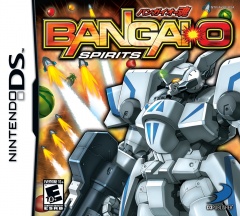 It seems I've been on a bit of a Treasure fix lately. Last month, I finally got around to playing Gunstar Heroes,
the first Virtual Console game I bought back in 2006 and Treasure's
very first game. The Genesis cult classic set the niche developer's tone
by throwing unprecedented amounts of enemies and projectiles at the
player from start to finish. A few weeks ago, I tried out the VC release
of N64 import darling Sin & Punishment, which warmed the heart of this old Star Fox 64 veteran. I've also begun playing that game's recent Wii sequel, Sin & Punishment: Star Successor, and should have my thoughts on that title up soon.
It seems I've been on a bit of a Treasure fix lately. Last month, I finally got around to playing Gunstar Heroes,
the first Virtual Console game I bought back in 2006 and Treasure's
very first game. The Genesis cult classic set the niche developer's tone
by throwing unprecedented amounts of enemies and projectiles at the
player from start to finish. A few weeks ago, I tried out the VC release
of N64 import darling Sin & Punishment, which warmed the heart of this old Star Fox 64 veteran. I've also begun playing that game's recent Wii sequel, Sin & Punishment: Star Successor, and should have my thoughts on that title up soon.
But today's subject is Bangai-O Spirits, a critically-praised title that didn't sell very much (as expected), though chalk up one more sale for Treasure: the $8.75 price tag on Amazon was an offer I couldn't refuse. This 2008 DS title is a sequel of sorts to the Dreamcast's Bangai-O (and its lesser-known, Japanese-exclusive N64 counterpart). True to Treasure's modus operandi, Bangai-O Spirits challenges the player to battle through 150+ stages filled with overwhelming swarms of enemy missiles and bullets on-screen. The game also features two- to four-player wireless cooperative and competitive battles and a robust set of stage editing and sharing features.
Treasure is a company known for making difficult games, and Bangai-O is noted as one of the developer's tougher titles. There's no question I'll crash and burn in my first thirty minutes with Bangai-O Spirits, but will I emerge from the wreckage seething or satisfied?
My JRPG Localization Wishlist
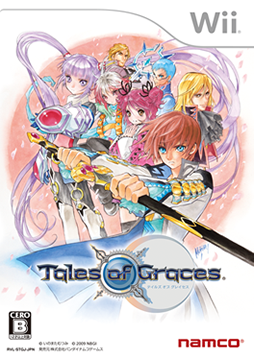 For years, Japan was the dominating force in the games industry. Ever
since Nintendo blasted onto the scene in the eighties, it's always been
my opinion that the developers in the land of the rising sun have had
the edge on everyone else. The Atari age has long since given way to
names like Nintendo, Sega, Sony, Capcom, Konami, Square, and so many
others. If I made a list of my hundred favorite games, I'd be willing to
bet that seventy or more of them come from Japan.
For years, Japan was the dominating force in the games industry. Ever
since Nintendo blasted onto the scene in the eighties, it's always been
my opinion that the developers in the land of the rising sun have had
the edge on everyone else. The Atari age has long since given way to
names like Nintendo, Sega, Sony, Capcom, Konami, Square, and so many
others. If I made a list of my hundred favorite games, I'd be willing to
bet that seventy or more of them come from Japan.
These days, however, the tide has shifted. The worldwide yearning for platformers and action games and traditional RPGs has been eclipsed by the first person shooter and sports game markets, two genres that Japanese developers are woefully unfamiliar with. Only the top games in each genre outside of Halo clones and Madden wannabes can make bank anymore, and developers are starting to play it safe with what they bring to the table. One genre affected by this trend is the JRPG, which has always had a focus in Japan, but also branched out to the world stage more often than not. These days, however, it seems Japan's favorite genre seems to be transforming more and more into Japan's shyest genre, rarely coming out to say hi to the rest of us.
In a rather shocking revelation, I've actually managed to find a hearty list of JRPGs that I pine for. I've never been the genre's biggest supporter, which doesn't surprise me in retrospect considering I never owned a SNES, Playstation, or Playstation 2 during their primes. However, I hereby pledge to buy any of the following games that come to America. I said the same thing about Tatsunoko vs. Capcom, thinking it would have no chance of arriving; I made good on my promise, bought TvC: Ultimate All Stars, and loved it. So it's on you now, localization teams. Make it happen.
Picross 3D
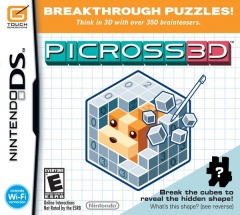 I can't name a lot of puzzle games I've honestly enjoyed. Tetris Attack, the Professor Layton series if those count, World of Goo? As you can tell I'm not a huge fan of the genre. I might play a puzzle game for a few rounds before I become bored, but Picross 3D was different, really different. I've already managed to beat over 200 levels and was becoming so obsessed with the game I was carrying my DS to work in case the opportunity came up over lunch.
I can't name a lot of puzzle games I've honestly enjoyed. Tetris Attack, the Professor Layton series if those count, World of Goo? As you can tell I'm not a huge fan of the genre. I might play a puzzle game for a few rounds before I become bored, but Picross 3D was different, really different. I've already managed to beat over 200 levels and was becoming so obsessed with the game I was carrying my DS to work in case the opportunity came up over lunch.
Picross 3D is not a typical puzzle game, it's slow moving and requires a lot of careful thought. There is little guessing involved and it does an excellent job of driving you on from puzzle to puzzle. As someone who had never played a Picross game before, I really had no idea what I was getting into until I read Nate's half hour review of the game. The game is cheap though so there's little investment for a chance of tons of hours of gaming. Plus it reminds me of my Kakuro obsession during my senior year of college.
Get ready for my shortest review ever!
LEGO Rock Band DS is the longtime sequel I've been waiting for
 No, I'm not really excited that it's another Rock Band game or even yet another LEGO game, but that LEGO Rock Band DS is essentially the direct sequel to Harmonix's original rhythm games: Frequency and Amplitude. For the unfamiliar, Harmonix's first two games were essentially the precursor to Rock Band where you played multiple instruments, but the catch was you had to flip between instruments after successfully playing a few measures of another. The gameplay was quite a bit more complex than Harmonix's original Guitar Hero games as there were multiple sets of scrolling notes that you had to keep an eye on to efficiently keep your streak going.
No, I'm not really excited that it's another Rock Band game or even yet another LEGO game, but that LEGO Rock Band DS is essentially the direct sequel to Harmonix's original rhythm games: Frequency and Amplitude. For the unfamiliar, Harmonix's first two games were essentially the precursor to Rock Band where you played multiple instruments, but the catch was you had to flip between instruments after successfully playing a few measures of another. The gameplay was quite a bit more complex than Harmonix's original Guitar Hero games as there were multiple sets of scrolling notes that you had to keep an eye on to efficiently keep your streak going.
Castlevania: Dawn of Sorrow
 Few gaming series have changed as much as Castlevania. What started off as an action platformer evolved into an exploration focused action RPG with the release of Symphony of the Night, a genre which has been dubbed “Metroidvania.” This style for the series wouldn’t be seen again for several years until it hit the most unlikely of platforms: the Game Boy Advance. Handheld gaming rekindled interest in the series, and since Circle of the Moon in 2001, six handheld Castlevania titles have been released. Dawn of Sorrow is the first one for the DS, and is a direct sequel to the final GBA Castlevania game. Since these games are rather short and focus heavily on post game content and speed runs, I’ve decided to do a half hour review. This has nothing to do with the fact that Dragon Quest IX comes out this week and I’d rather play that than write. Nothing at all!
Few gaming series have changed as much as Castlevania. What started off as an action platformer evolved into an exploration focused action RPG with the release of Symphony of the Night, a genre which has been dubbed “Metroidvania.” This style for the series wouldn’t be seen again for several years until it hit the most unlikely of platforms: the Game Boy Advance. Handheld gaming rekindled interest in the series, and since Circle of the Moon in 2001, six handheld Castlevania titles have been released. Dawn of Sorrow is the first one for the DS, and is a direct sequel to the final GBA Castlevania game. Since these games are rather short and focus heavily on post game content and speed runs, I’ve decided to do a half hour review. This has nothing to do with the fact that Dragon Quest IX comes out this week and I’d rather play that than write. Nothing at all!
